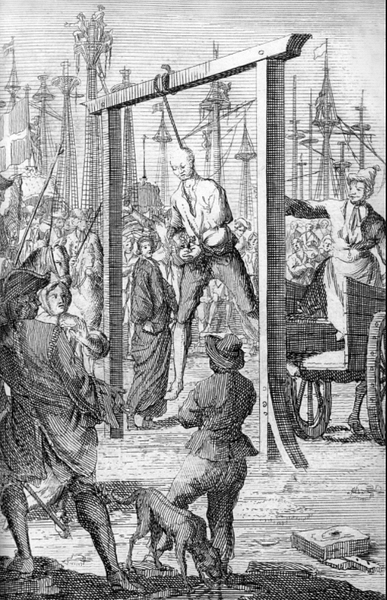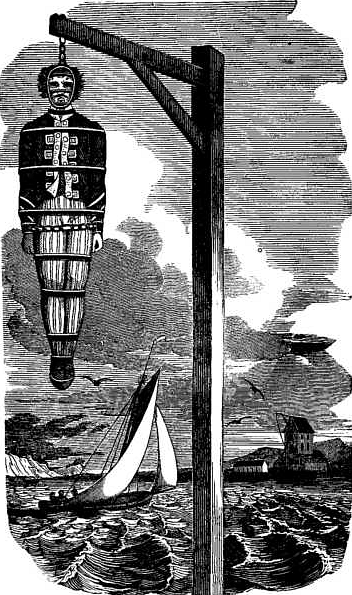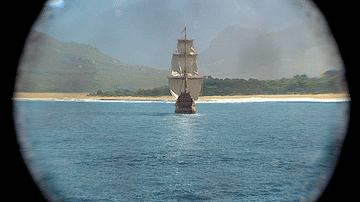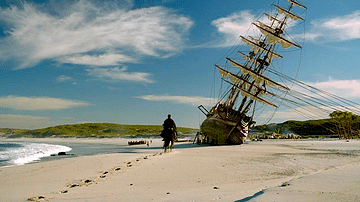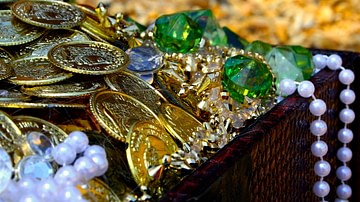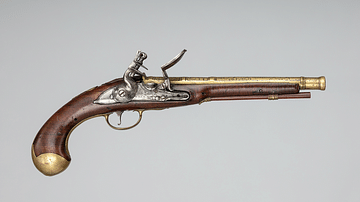Pirates in the Golden Age of Piracy (1690-1730) both dished out and received a wide range of imaginative punishments. Victims of piracy endured torture, floggings, and ceremonies of humiliation, but when brought to justice, the pirates were given such punishments as lengthy prison sentences, transportation to work in the deadly conditions of African mines, or public execution by hanging.
Punishments Between Pirates
Floggings
The use of a whip to dish out punishments was a common occurrence on ships of all kinds of the period. For pirates, the risk of bearing such treatment was much reduced since a captain rarely dared to use such methods on a crew that had probably turned pirate in the first place in order to escape such harsh features of a life at sea. A flogging was usually only decided upon as the form of punishment if the whole crew, or at least the majority, agreed that the man had broken one of the ship’s articles, that is the list of rules they swore to abide by. The man who dished out the flogging on a pirate vessel was the quartermaster. Floggings were given for such misdemeanours as bringing women on board, striking another man, or not keeping weapons in an efficient state of readiness.
If a mariner was flogged, then he was tied to the mast or a grating and lashed on his bare back with a cat-o’-nine-tails. This special kind of whip consisted of nine lengths of rope, each of which was around one-quarter of an inch in diameter (c. 6 mm) and up to 2 feet (c. 60 cm) long. Each of the nine lengths had three or more knots to make the whip’s bite even sharper - sometimes more knots were added for more severe crimes. During a flogging, the sailor often bit on a bullet so that he did not cry out and raise the ridicule of his crewmates. If he did call out with the pain, then his mates would thereafter describe him disdainfully as a 'nightingale'.
Keelhauling
To be keelhauled was just about the worst punishment a sailor could expect to be given short of death, and even here his chances of surviving the ordeal were no more than 50:50. The punishment involved tying a person with rope, throwing them overboard, and then dragging them either under the ship from one side to the other or along the entire length of the ship. Even if the victim escaped drowning, they would be severely cut and bruised from being dragged against the ship’s barnacle-encrusted hull.
Marooning
For mariners guilty of a serious crime like mutiny, theft, or cowardice, their punishment could be a delayed death sentence. The sailor was marooned, that is deposited on a remote island and given nothing but a keg of water and a pistol; sometimes they were even stripped naked. An alternative to leaving the person on land was to set them adrift in a small boat with no oars or a single oar. Fully aware that thirst and starvation were all they had to look forward to, some mariners asked to be shot straight away. For others, the gift of a pistol allowed them to end things before they went mad from the privations. The most famous mariner to be marooned was Alexander Selkirk (1676-1721) who was left on the Juan Fernández Islands in the Pacific in 1704. Another man to be marooned was Edward Low whose crew had had enough of his sadistic antics with friend and foe alike. The origin of the word 'maroon' is the Spanish term for an escaped slave, cimarrón, meaning wild or untamed.
Punishments on Innocent Captives
Torture
While most pirates were only interested in loot, some captains were particularly vicious towards captured crews, especially if they thought they were hiding valuables somewhere on board. There was, too, the idea that torturing a few victims would soon spread the word amongst merchant shipping so that in the next capture the crew would be much more likely to be compliant.
Tortures, sometimes euphemistically called 'pirate persuasions', included being beaten, whipped, cut, and having lit matches put between your fingers. A favourite technique borrowed from the earlier buccaneers was to tie a cord around a captive’s head and tighten it until the eyes popped out. A punishment used in the Royal Navy which was adopted by some pirates to make captives talk was ducking at the yardarm. This involved tying a rope around the waist and under the groin and arms of the victim who was then hoisted up a yardarm. The rope was then dropped so the victim plummeted briefly into the sea before they were hauled back up and dropped again and again until they talked.
The English pirate Charles Vane (hanged 1721) was particularly brutal. At Vane’s trial, eyewitnesses and former victims recounted a litany of tortures. Mariners were beaten, cut, and even hanged. One victim was tied to the ship’s bowsprit and then tortured with burning matches. Another infamous English pirate was Henry Every (b. 1653) who captured the Ganij-i-Sawai, a treasure ship of the Mughal emperor, in 1695. Many of the captured passengers were tortured to reveal their valuables, and then raped, killed, and thrown overboard.
Another sadistic captain was the Welshman Bartholomew Roberts, aka 'Black Bart' Roberts (c. 1682-1722). Captain Roberts was hugely successful in capturing many ships, but he still inflicted needless tortures anyway. In one notorious episode in October 1720, Roberts ordered his men to cut the ears off a group of Dutch captives, some were hanged and their bodies used for target practice. On another occasion, Roberts hanged the governor of Martinique from his own yardarm.
The cruelest of all pirates was the Englishman Edward Low, active in the Caribbean and eastern Atlantic from 1721 to 1724. 'Ned' Low built up a catalogue of despicable crimes. In 1722, he cut up and hanged a group of Portuguese passengers which included two friars. A cook on a French vessel was tied to the mast and the ship burned to a wreck. A Portuguese captain who had thrown his purse overboard had his lips cut off, and these were then burned in front of him. A fisherman captured off Nantucket had his ears cut off before being shot dead. Another fisherman was forced to eat his own ears while a captain taken off Rhode Island had his heart cut out which another prisoner was forced to eat.
Similarly, a gunner in the crew of the English pirate Edmund Condent (active 1718-1720) was said to have once boiled and eaten the heart of an Indian captive who had threatened to blow up their pirate ship. Condent was another captain who took pleasure in mutilating his victims, cutting off the noses and ears of several Portuguese captives off the coast of Brazil.
Humiliations
Just short of torture were some of the games pirates devised for their captives. One such 'sport' was blooding and sweating which involved making a captive run between a line of sailors who used sail needles to jab the victim as they passed. The victim was then shut inside a barrel full of cockroaches. A softer alternative was to make the victim run endlessly around the mainmast. The point of a cutlass was used to persuade the victim to keep on running until they collapsed from exhaustion.
Walking the Plank
There is not a great deal of evidence that pirates during the Golden Age made people walk the plank, that is being blindfolded, having one’s hands tied, and then made to walk out on a plank jutting out from the deck over the sea. The punishment has, nevertheless, featured in many fictional pirate tales, and some sources claim that Stede Bonnet (hanged 1718) invented it as a way to entertain his crew and dispose of unwanted passengers. The idea of this unusual form of execution may derive from 1st-century BCE Cilician pirates who, according to Plutarch (c. 45 - c. 125 CE), made Roman captives walk along a ladder on water. Another origin may be the habit of making mariners suspected of being drunk walk in a straight line along a plank laid out on deck.
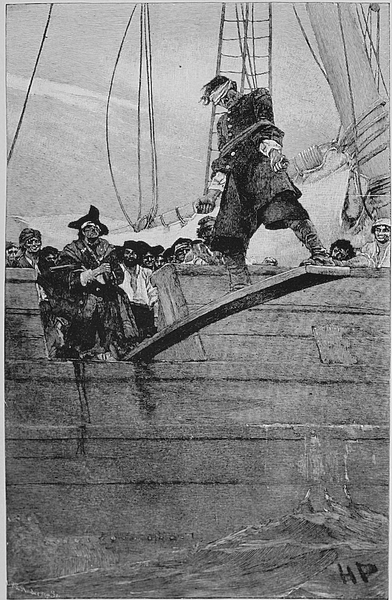
Punishments for Captured Pirates
Flogging & Branding
In the Indian Ocean during the Golden Age, the British Admiralty gave the East India Company the right to pursue and try pirates from 1683. Consequently, pirates were now in danger of meeting their just deserts wherever they caused havoc. A common punishment was to be flogged on board a single ship or sent around all the ships in the port and flogged at each one of them (a punishment also used in the Royal Navy). In the Indian Ocean, pirates were so numerous that those captured were often branded with a letter P on their foreheads using a red-hot iron. In this part of the world, death sentences were carried out by hanging the pirate from a yardarm.
Prison
Early on in the Golden Age, if caught, some pirates received a pardon, especially if they were but minor members of the crew or were very young men. As the period wore on and piracy worsened, the authorities got a whole lot tougher. Pirates everywhere risked imprisonment as the least bad sentence if they were ever caught. Many pirates died while awaiting trial, either from their wounds or from the diseases which were rife in prisons. For most, a lengthy prison sentence was a real prospect if they could not convince the court that they had been an unwilling member of a pirate crew. This defence had to be done by the pirate - most of whom were completely uneducated - since they were not permitted legal counsel. Colonial prisons were particularly grim, but prisons back in England were not much better. Some prison sentences involved hard labour, for example in the penal colonies in West Africa where prisoners worked in mines and where the chances of survival were low indeed.
Hangings
The most common form of punishment for a captured pirate towards the end of the Golden Age was to be hanged, usually immediately after the trial. These executions took place in public and often in a location where passing mariners would see the act. In London, pirates had their own exclusive place of execution, known as Execution Dock in Wapping on the bank of the River Thames. Typically, several pirates were hanged together, especially when the war on piracy intensified and whole crews were condemned en masse. The condemned men were escorted from prison - usually Newgate or Marshalsea - with the group headed by an officer who carried a silver oar, which symbolised the authority of the High Court of the Admiralty.
The place of hanging contained several points of particular significance. The location near the sea was to signify the crimes had been committed by mariners while the precise location at the point of low tide was to remind that the Admiralty was responsible for carrying out the sentence since the area beyond low tide was for crimes dealt with by the civil authorities.
The condemned men stood on the primitive wooden gallows while a chaplain said his piece and offered a prayer for the soon-to-be departed. The men were then permitted to speak their last words, and these speeches were often recorded and distributed in print to an eager public. The pirate was then pushed off the ladder he had climbed, and he usually died from strangulation rather than a broken neck. Once dead, the body was taken down and staked out on the beach or tied to a wooden post and left for three tides. The remains were then buried in an unmarked grave. This procedure was followed by the authorities responsible for executions in the colonies, a right granted from 1701. The largest group execution during the Golden Age was at Cape Coast Castle, Guinea in West Africa in 1722. 52 of the captured crew of Bartholomew Roberts were hanged there.
For particularly notorious pirates, usually the captains, they were hanged and then their body was hung to rot in an iron cage. The Scottish privateer turned pirate Captain Kidd (c. 1645-1701) was found guilty of piracy and murder at his trial in London in May 1701. He was hanged, and his body was then tarred and hung in a cage by the River Thames. Kidd's remains were visible to passing ships for two years. This form of punishment was still being dished out 20 years later.
The English pirate John Rackham, aka 'Calico Jack', was found guilty of four charges of piracy and hanged in Jamaica in November 1720. His corpse was also hung in a cage as a public deterrent, this time on the appropriately named Deadman’s Cay of Port Royal. Charles Vane received the very same treatment a year later.
There was certainly no love lost between pirates and the authorities, although, if anything, this resulted in pirates fighting desperately to avoid being captured alive. Blackbeard, aka Edward Teach, had to be shot five times and given 20 sword cuts before he finally fell in November 1718. Lieutenant Maynard, who had captured the notorious pirate, then stuck Blackbeard’s head on the prow of his ship as a warning to others. Bartholomew Roberts had instructed his men to dispose of his body at sea to avoid ending up in a cage, a duty they followed through when he was killed in action in February 1722. One thing was certain, pirates could not complain that they did not know the terrible punishments that awaited them when they were, as almost all were, finally brought to justice.


